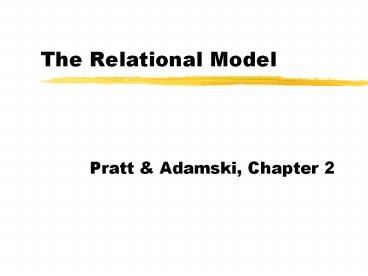The Relational Model - PowerPoint PPT Presentation
Title:
The Relational Model
Description:
Relationships. Operations. Relation. Attributes. Occurrences or. Tuples. Relation Requirements. Attributes are single valued, and all entries have the same data type ... – PowerPoint PPT presentation
Number of Views:16
Avg rating:3.0/5.0
Title: The Relational Model
1
The Relational Model
- Pratt Adamski, Chapter 2
2
Relational Algebra
- Project
- Select
- Join
- Union
- Intersect
- Subtract
- Product
- Division
3
Relational Database
- Based in formal set theory
- Most common data structure
- Provable design principles
4
Relational Definition
- Relations
- Attributes
- Relationships
- Operations
5
Relation
Attributes
Occurrences or Tuples
6
Relation Requirements
- Attributes are single valued, and all entries
have the same data type - Each attribute has a distinct name
- All values in a column are values of the same
attribute - The order of columns is irrelevant
- Each row is distinct
- The order of rows is irrelevant
7
Premiere Products Example
8
Row OperationsSelect, Project, Join
- SELECT returns desired rows
- PROJECT returns desired columns
- JOIN creates one table from two by matching
specified column values in the two tables
9
Set OperationsUnion, Intersection, Difference
- Returns the union, intersection, or difference
of rows in two tables - Note both tables must be union compatible.
They must have the same number of columns and the
corresponding columns must have the same data
types.
10
Table OperationsProduct, Division
- PRODUCT (Cartesian product) produces a table with
the columns of both tables and rows consisting of
all combinations of rows from the two tables. If
table A has m rows and table B has n rows, the
product will have mn rows. - DIVISION (A divided by B where the columns in B
are also in A) produces a table consisting of
columns in A that are not in B and match all the
rows in B.































